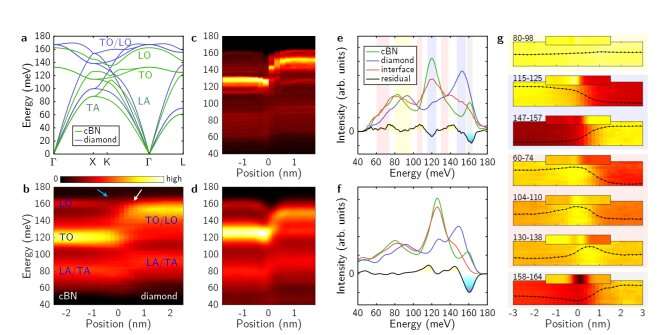a, Calculated phonon dispersion for bulk cBN (green) and diamond (blue). b, Measured EELS line profile across the interface. The origin of the horizontal axis is at the interface. Blue and white arrows are guides to the eye that mark the intensitydecrease of cBN LO phonon and the energy shift of the diamond optical phonon. c, Calculated phonon DOS projected onto atom layers. d, Calculated EELS scattering cross section. e, EEL spectra acquired in cBN (green), in diamond (blue), and at the interface (red). The black curve with gradient filling isthe interface component that cannot be expressed as a linear combination of two bulk spectra. f, Corresponding calculation results. g, Energy-filtered EELS maps. Overlaid lines are averaged intensity profiles, whose contrast has been adjusted for clarity. Small inset bars at the top of each map arecalculated maps. Energy integration windows are indicated by numbers (in meV) at the top-left corner of each map, and are also shaded in e. In all colormaps, the lower color limit is fixed to zero. Credit: School of Physics, Peking University
Phonons—the quasiparticle describing lattice vibrations in solids—directly dictates various properties of solid state systems, such as the thermal conductivity, electron mobility, structural stability and conventional superconductivity. Since in real low-dimensional crystals the phonon structures depends on both real space and reciprocal space, it is very chanlleging to experimentally measure them. In a recently published paper on Nature, a research team from Peking University headed by Prof. Gao Peng solved this problem by using their newly developed technique termed as 4-D-EELS. They successfully measured the phonon modes (i.e., density of states, spatial distribution and dispersion relationship) at a heterointerface between cubic boron nitride and diamond. This study is useful in understanding and the subsequently controlling properties of solid interfaces.
Theoretical description of phonons was well developed in the last century, such as the famous book Dynamical Theory of Crystal Lattices written by the Nobel laureate Max Born and the Chinese physicist Huang Kun. Various experimental probes have also been developed to measure phonon properties. At the interface between two crystals, new phonon modes distinct from two bulk materials can emerge due to the breakdown of translation symmetry. Phonon modes localized at interfaces were predicted to exist decades ago, but they have eluded direct experimental observation to date because they are confined to only within several atom layers near the interface. To probe them, nanometer spatial resolution, millielectronvolt energy resolution and ultrahigh detection sensitivity are simultaneously required; to further measure their dispersion relation and related properties, momentum resolution is also needed. None of the traditional spectroscopic techniques can meet these stringent requirements.
Earlier this year, the research group in Peking University developed an electron energy loss spectroscopy technique (termed 4-D-EELS) based on a scanning transmission electron microscope. This technique offers high spatial, energy and momentum resolutions with high detection sensitivity, enabling nanoscale phonon dispersion measurements (Nature Communications, 12, 1179 (2021)). It can achieve a good balance between spatial and momentum resolutions, being only ~15% worse than the diffraction limit—the ultimate theoretical bound set by the uncertainty principle.
In their new paper entitled "Measuring phonon dispersion at an interface" in Nature, the authors used a cubic boron nitride / diamond heterointerface as example, first measured the local phonon density of states at the atomic scale, and successfully observed phonon modes localized at the interface and phonon modes isolated from the interface. Then they measured the dispersion relation of interface modes with carefully balanced spatial and momentum resolutions. The experimental observations are in good agreement with first-principle calculations. The observed interface modes are expected to substantially affect thermal conductance across the interface and carrier mobility of the two-dimensional electron gas at the interface. The ability to measure local phonon dispersion should also be useful in studying topological interface phonon modes and even in understanding interface superconductivity.
More information: Ruishi Qi et al, Measuring phonon dispersion at an interface, Nature (2021). DOI: 10.1038/s41586-021-03971-9
Journal information: Nature
Provided by Peking University
























